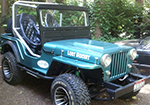UPDATE: This ad published in the Los Angeles Times, June 15, 1962, by the Alaskan Camper Factory, welcomed Dorothy and Louise back into the United States after their trip around the world in an FC-170 (with an Alaskan camper, of course).
===================
Originally Published October 06, 2012: Highways Across the Horizon was written by Dorothy Rogers, who previous wrote Jeopardy in the Jeep. I received a copy of it in the mail last week. I knew the book was about traveling through Asia, but there were two things I didn’t know. The first think I learned was that she and her travel partner Louise, traveled all the way around the world, starting and ending in New York. The second surprise was their vehicle of choice: a FC-170 with a camper. Craig confirmed today that Dorothy and Louise piloted only the third known FC to make it around the world. I can’t wait to read about their adventure.
Here are FC related pics:






























